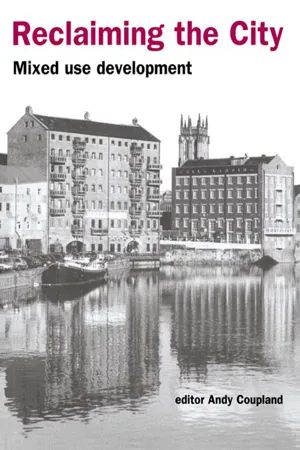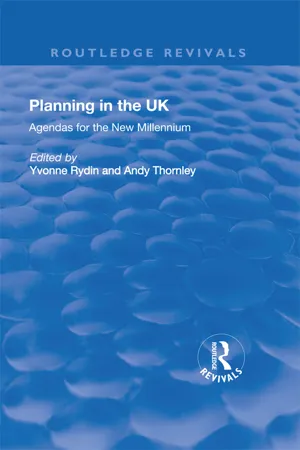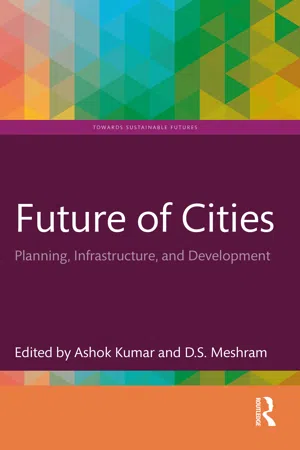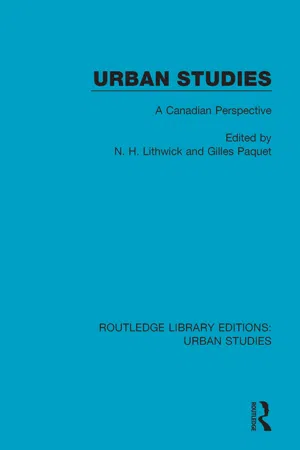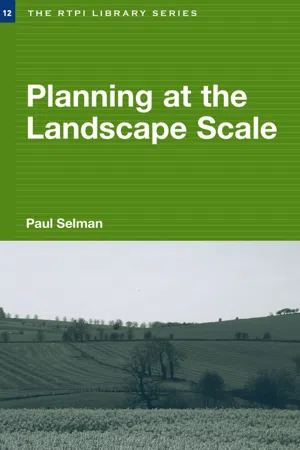Geography
Mixed Land Use
Mixed land use refers to the coexistence of different types of land use within a specific area, such as residential, commercial, and industrial activities occurring in close proximity. This concept promotes efficient use of space and resources, encourages walkability, and can create vibrant, diverse communities. Mixed land use can enhance the functionality and livability of urban areas.
Written by Perlego with AI-assistance
Related key terms
Related key terms
1 of 4
Related key terms
1 of 3
7 Key excerpts on "Mixed Land Use"
- eBook - ePub
Reclaiming the City
Mixed use development
- Andy Coupland, Andy Coupland(Authors)
- 2005(Publication Date)
- Routledge(Publisher)
As 1994 progressed there were intimations in the speeches of the Secretary of State John Glummer that the government, or at least the Department of the Environment, was moving towards an appreciation of the role that mixed use development might make as an agent of sustainability. By early the following year, the Department's perception that Mixed Land Use may be one factor leading to the delivery of sustainability was receiving regular promotion. At a conference in Manchester in July 1995, the Secretary of State described the existence of an emerging consensus around the view that ‘development is more sustainable if it produces a mixture of uses’. Again at pains to distance himself from the adherence to zoning practised by his predecessors, Gummer strikes a progressively more evangelical tone:Segregation of land uses, encouraged in the past, is not relevant now. The trend back to mixed usage brings a number of potential benefits. It ensures vitality through activity and diversity. It makes areas safer. It also reduces the need to travel, making people less reliant on cars, bringing welcome environmental benefits (DoE, 1995b).More recently in 1996 the government has honoured the pledge contained in the Sustainable Development Strategy to develop and publish Indicators of Sustainable Development for the United Kingdom. Produced by an interdepartmental Working Group, the report presents a set of indicators on 21 topics ranging from leisure and tourism to overseas trade. In the description of indicators relating to the re-use of land the report acknowledges that commercial and residential redevelopment within existing urban areas contributes to both their vitality and viability. Support for mixed use as an agent of sustainable development is apparent, if not altogether enthusiastic:(Mixed redevelopment) can also improve the quality of life and also accessibility for those people without a car by increasing and widening the range of services and facilities available and thereby reducing the need for people to travel to other towns for work, shopping and leisure (DoE, 1996 , p.54).Conclusion
This chapter has traced the evolution of sustainable development from its genesis as an objective in 1987, through perceptions of it as a process, to the formulation of policy to guide its practical application. In moving from being an iconic statement concerning the global environment to an expression combining ideal intent and pragmatic implementation, sustainable development has entered the everyday language of the nation. Within this setting a significant ideological shift within planning regarding the zoning of land use has occurred. Mixed use development has emerged both as a philosophy and as one acceptable element of the solution to the problem of delivery of sustainable development, replacing its earlier position as an inevitable consequence of laisser-faire - eBook - ePub
Planning in the UK
Agendas for the New Millennium
- Andy Thornley, Yvonne Rydin(Authors)
- 2018(Publication Date)
- Routledge(Publisher)
less land use heterogeneity in neighbourhoods not more. Sustainable land use policy in this respect works against the traditional market at a very fundamental level. That is not to say that it will be unsuccessful in changing the market; only that policy makers should have a realistic view of the markets they are trying to influence. Our research aims to make a statement about the demand-side of the compact city question with the belief that urban policy that disregards or glosses over the preferences of citizens will fail, either in the sense of being ignored or in the sense of creating social problems for the future. The study aims to measure householders’ demand for innovative and possibly contentious forms of urban living, as well as for more traditional sustainable living environments such as dense inner suburbs. The next section summarises the background to the issue. Subsequent sections present: a theoretical model of locational choice in which the effects of density and land-use mix are made explicit; the statistical choice model; the experimental and survey designs; initial findings; and conclusions.Background
The notion of the compact city with mixed-use neighbourhoods has gained support at all levels of political decision making since the Brundtland Report first popularised the sustainable cities debate in the mid 1980s. The Commission of the European Communities’ (CEC) Green Paper on the Urban Environment (1990), criticises “the almost clinical separation of land-uses” (p48) in modern cities and proposes that “strategies which emphasise mixed use and denser development are more likely to result in people living close to work places and the services they require from everyday life”(p60). Since the Green Paper, European, national and local policy and discussion documents have repeated the dual theme: greater densities and mixing of land-uses will significantly contribute to emissions and energy consumption reduction via shorter and possibly less frequent intra-urban car-based trips and will raise the vitality, viability and safety of urban areas. At the European level, the message has been developed strongly in the Commission-funded report “Mixed uses in buildings, blocks and quarters” (CEC 1993) and the European Sustainable Cities Report and Good Practice Guide (CEC 1995a, 1995b). At a national level, the same theme is promoted in the UK Government’s Strategy for Sustainable Development (DoE and FCo, 1994) and the Quality in Town and Country discussion document (DoE 1994). It is translated into formal guidance through planning policy guidance notes, such as PPG 13 (DoE and DoT 1994), PPG6 (DoE 1996) and PPG3 (DETR, 2000). At a local level, development briefs and strategy documents throughout the country contain pro mixed-use and densification policies. - eBook - ePub
Sustainable Urban Development Volume 2
The Environmental Assessment Methods
- Mark Deakin, Gordon Mitchell, Peter Nijkamp, Ron Vreeker(Authors)
- 2007(Publication Date)
- Routledge(Publisher)
Only above a certain scale level intensification can lead to multi-functional land use, since more land becomes available for other functions. The interweaving of land use is defined by ‘use of the same area for several functions’, but it is preferable to call this ‘diversity’. Interweaving, then, can be seen as the degree in which different functions touch upon other functions. For example, within a project area of 400m 2, four different functions of 100m 2 each may be less interwoven than the same number of functions having in total 100 m 2 per function as well, but scattered over the project area. The combination of different land use functions at one location means that the land use intensity increases. Since in many countries the intensity of land use has increased in the last decades and will probably increase further, it is difficult to develop a clear definition of multi-functional land use. The concept of multifunctional land use is very broad. It can range from a combination of two economic functions to the combination of all nine economic functions shown in Figure 15.1, depending on the chosen scale level. In this chapter, for practical reasons, the project level has been chosen as the scale level. The boundaries of the project define the area that will be analysed. When seen from a project perspective, it is very hard to indicate whether projects are multi-functional or not. A practical definition of multi-functional land use should therefore reflect that the concept is best understood as a relative, non-binary one: it is better to define a degree of multi-functionality than to make a strict demarcation between mono- and multi-functional land use patterns. A more suitable definition of multi-functional land use from a developmental perspective would be: A land use pattern is said to become more multi-functional when the average number of functions and/or units of land increases in the area considered - eBook - ePub
Future of Cities
Planning, Infrastructure, and Development
- Ashok Kumar, D.S. Meshram, Ashok Kumar, D.S. Meshram(Authors)
- 2022(Publication Date)
- Routledge India(Publisher)
Special and Hazardous Industrial Open Space Use Zone 7 Utility Utility Natural Zone Non-Urban Institutional Water Bodies Use Zone 8 Agricultural and Water Bodies Agricultural and Water Bodies Green Zone Open Space & Recreational Transportation Use Zone 9 Transportation Transportation Non-Urban Special Reservation Use Zone 10. Mix Use Zone* Agricultural Defence/Military Lands, Burial Grounds, Cremation Grounds, etc. 11 Urbanisable Special Area Development Plan Areas* Mix Use Zone was added as a separate paragraph under the nine defined land-use categories in the Master Plan 2001.A similar shift was visible in the second revision for Delhi Master Plan, 2021, which came into effect in February 2007. The chapter on development regulations describes nine use categories with 26 use zones as well as an additional line referring to a mixed-use zone, which is defined as ‘[a] use zone in Land Use Plan can be indicated as consisting of more than one use zones’. The plan was modified over time, and although no changes were made to the classification system, it added a chapter for a transit-oriented development zone.Similarly, the Hyderabad Metropolitan Region Development Plan, 2031 added a multiple-use zone, a conservation (agriculture) zone, and a special reservation zone that included heritage areas. Chennai’s plan for 2026 also included a mixed residential zone, and Mumbai’s Plan for 2031 inserted multiple-use and special reservation zones.Reasons for Shifts
The previously described shift began in the 1990s and became evinced in changes in zoning regulations by the first decade of the 21st century. In part, this shift can be attributed to three significant factors: (1) the emergence of environmental and heritage discourse in India beginning in the 1980s; (2) the opening of the economy in the 1990s, which paved the way for extensive private-sector urban development; and (3) the rise of information technology, which engendered some changes that are beginning to emerge in recent years. - eBook - ePub
Urban Studies
A Canadian Perspective
- N. H. Lithwick, Gilles Paquet(Authors)
- 2017(Publication Date)
- Routledge(Publisher)
A generalized concept is one which is being broadened. What is of interest then is not simply the state of development of the concept but rather the process through which it is being generalized. This can be studied most effectively by examining the genealogy of the concept and by classifying its uses. We must emphasize that we are not dealing as yet with a general concept – that is, one which has crystallized into its final form. General concepts can best be analyzed through the construction of an ideal-type demonstrating how it embodies components borrowed from the different disciplines. It is the very nature of the concept currently being generalized which has led us to follow the approach suggested above. This approach better reveals the possibilities of the concept by examining it at work, so to speak, in the various studies which have used it.In this process we shall encounter necessarily many other ambivalent notions which could be usefully anatomized in the same fashion. For instance, we shall deal with the notion of density; and although we shall not analyze it here, hopefully it will provide some insight into other “generalizable” concepts over the span of other disciplines. The process leading to generalization is much more crucial here than the outcome of any such process. Consequently we have not attempted an exhaustive review of the diverse contexts in which the concept of land use is employed; the items presented have been selected for their illustrative usefulness.The choice of this particular concept for our demonstration is amply justified by its importance both in economics and geography. Land use is the geographical image of the results of the operations of the urban land market; it is also inversely the dimension of geographical space inserted into the market place. Whether one deals with types of land use, or with the intensity or density of land use (this is the link between land use and density concepts), one is clearly within this area that some call economic geography and others geographical or spatial economics. This concept of land use permeates both disciplines and is mentioned in at least two thirds of this book. Moreover, in a venture of this sort, it is preferable to start with the intersection of economics and geography since their respective property-spaces2 - eBook - ePub
- Paul Selman(Author)
- 2006(Publication Date)
- Routledge(Publisher)
et al., 2000). In essence, landscape is multifunctional in two key senses: from a cultural point of view it hosts many different human activities such as farming, settlement and recreation; and from an environmental point of view, it sustains multiple climatic, hydrological, edaphic and ecological processes. In respect of both of these, planners and managers aspire to ensure productivity, diversity, stability and integrity (Naveh and Lieberman, 1994). Haines-Young and Potschin (2000) have interpreted multifunctionality in terms of the three attributes of ‘simultaneity’ (different material processes in nature and society taking place simultaneously), ‘co-existence’ (embracing different spheres such as ecology, economics, culture, history and aesthetics) and ‘inter-activity’ (i.e. simultaneity, combined with an understanding of the interactions between environmental and socio-economic systems).Landscape multifunctionality stands in sharp contrast to the dominantly ‘single objective’ planning of the past (Antrop, 1999; Pinto-Correia and Vos, 2004). During the 20th century, landscape functions – for instance, of nature conservation, natural resource management and leisure (cf. Klijn and Vos, 2000) – have tended to become segregated in most European landscapes, as a result of specialisation and intensification of production. Jongman (2002) considers this functional separation of land to be an underlying contributor to many environmental problems. Latterly, it has been argued (e.g. Brandt and Vejre, 2003) that new styles of spatial planning provide opportunities for promoting multifunctionality in space and time. Vos and Klijn (2000) consider that multifunctionality is highest when maintained at various levels – field, farm and landscape – and note that this was typical of traditional land use systems that combined arable, woodland and pastoral components in varying ways. Whilst there is little point in pretending that late-modern society can simply revert to pre-industrial mixed farm and forest, a key challenge for landscape scale planning may well be associated with recapturing the serendipitous balance between economic need, emotional attachment and ecological dynamics that appears to have transpired in many traditional, low-intensity landscapes. - Andrew Skidmore(Author)
- 2017(Publication Date)
- CRC Press(Publisher)
11Land use planning and environmental impact assessment using geographic information systems
Egide Nizeyimana, Gary W. Petersen and Joan C. Looijen11.1 INTRODUCTIONLand use planning consists of making decisions about the use of land and resources (Food and Agricultural Organization 1993). It is conducted primarily to achieve the best use of land, and its implementation is often driven by current and future people’s needs in terms of productivity and environmental sustainability. Land use planning may not be as important in sparsely populated countries and communities. In sparsely populated countries or communities, the land use planning is straightforward and is usually aimed at finding the best locations for each of the potential land uses at hand; in other words, it is reduced to a land evaluation (FAO 1976; Rossiter 1996). In highly populated communities, however, land use planning consists of a more elaborate analysis due to conflicts between competing uses (Brinkman 1994). In this case, planning activities are tailored primarily to making the optimal uses of the limited land and associated resources.Land use planning may be conducted at different levels or scales of decision-making: national, district, local, farm, or field level. The national level is concerned primarily with national priorities as driven by land use policy and legislation. In some countries, land use planning consists of a multi-year program detailing goals at every step of the action plan. Land use planning at a district level often deals with development projects. Local planning may be carried out at the community or watershed level. Farm-level land use planning involves determining best management practices for different fields in the farm. The land use planning process differs from project to project depending on the goals and availability of data. Most projects involve sequential organization of thoughts, evaluation and comparison of alternative land uses in terms of their suitability and impacts to the environment, and finally design and implementation of the plan. While the Food and Agriculture Organization (FAO) land use planning process (Figure 11.1 ) emphasizes the regional and nationwide planning, that of the United States Department of Agriculture-Natural Resources Conservation Service (USDA-NRCS) is primarily concerned with conservation planning and nutrient management at the farm level (Figure 11.2
Index pages curate the most relevant extracts from our library of academic textbooks. They’ve been created using an in-house natural language model (NLM), each adding context and meaning to key research topics.
Explore more topic indexes
Explore more topic indexes
1 of 6
Explore more topic indexes
1 of 4
